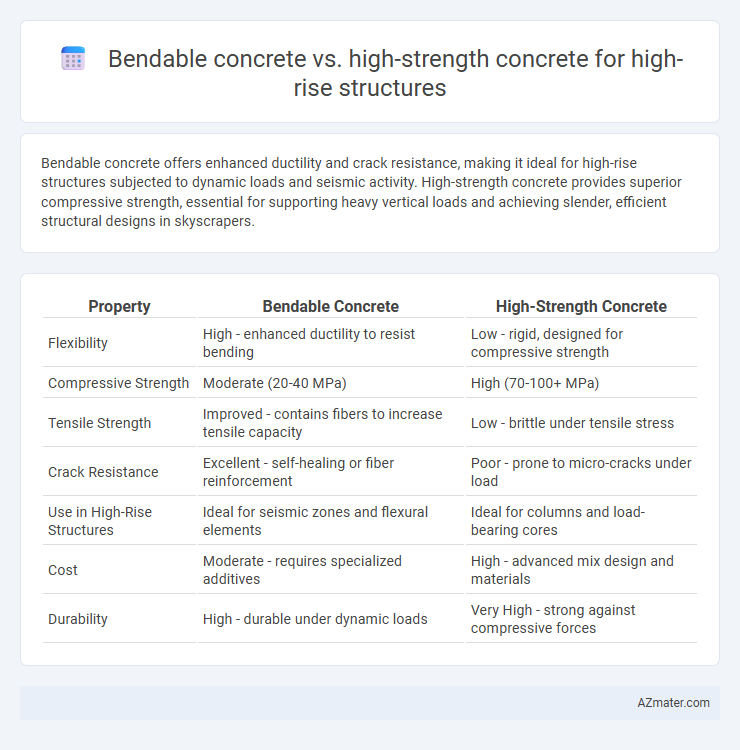Bendable concrete offers enhanced ductility and crack resistance, making it ideal for high-rise structures subjected to dynamic loads and seismic activity. High-strength concrete provides superior compressive strength, essential for supporting heavy vertical loads and achieving slender, efficient structural designs in skyscrapers.
Table of Comparison
| Property | Bendable Concrete | High-Strength Concrete |
|---|---|---|
| Flexibility | High - enhanced ductility to resist bending | Low - rigid, designed for compressive strength |
| Compressive Strength | Moderate (20-40 MPa) | High (70-100+ MPa) |
| Tensile Strength | Improved - contains fibers to increase tensile capacity | Low - brittle under tensile stress |
| Crack Resistance | Excellent - self-healing or fiber reinforcement | Poor - prone to micro-cracks under load |
| Use in High-Rise Structures | Ideal for seismic zones and flexural elements | Ideal for columns and load-bearing cores |
| Cost | Moderate - requires specialized additives | High - advanced mix design and materials |
| Durability | High - durable under dynamic loads | Very High - strong against compressive forces |
Introduction to Modern Concrete Innovations
Bendable concrete, also known as engineered cementitious composite, offers enhanced ductility and crack resistance compared to traditional materials, making it ideal for high-rise structures subjected to dynamic loads. High-strength concrete, characterized by compressive strengths exceeding 70 MPa, enables slender, lightweight designs that reduce overall structural weight and material usage. Modern concrete innovations increasingly combine these properties to optimize durability, safety, and performance in skyscraper construction.
Understanding Bendable Concrete: Key Features
Bendable concrete offers enhanced tensile ductility and crack control due to engineered fiber reinforcement, making it ideal for high-rise structures subjected to dynamic loads and seismic activity. Unlike high-strength concrete, which primarily emphasizes compressive strength above 70 MPa, bendable concrete maintains moderate strength with superior flexibility and damage tolerance. This innovative material reduces structural brittleness, improves durability, and extends service life in tall buildings.
High-Strength Concrete: Definition and Properties
High-strength concrete (HSC) is characterized by a compressive strength exceeding 6,000 psi (approximately 41 MPa), making it ideal for high-rise structures due to its superior load-bearing capacity and durability. Its dense microstructure, achieved through low water-to-cement ratios and often enhanced with silica fume or fly ash, leads to improved mechanical properties and reduced permeability. HSC offers enhanced resistance to environmental stressors and contributes to slimmer structural elements, optimizing space and reducing the overall weight of tall buildings.
Comparative Structural Performance
Bendable concrete offers superior ductility and crack control compared to high-strength concrete, which excels in compressive strength but is more prone to brittle failure in high-rise structures. The enhanced flexibility of bendable concrete enables it to absorb and dissipate seismic and wind loads more effectively, improving overall structural resilience. High-strength concrete remains advantageous for load-bearing elements requiring extreme compressive capacity, while bendable concrete provides better performance in components subject to dynamic stresses and deformation.
Flexibility vs. Compressive Strength
Bendable concrete offers enhanced flexibility and crack resistance, making it ideal for high-rise structures subject to dynamic loads and seismic activity, whereas high-strength concrete provides superior compressive strength crucial for supporting massive vertical loads and ensuring structural stability. The increased ductility of bendable concrete reduces brittle failure risks, while high-strength concrete's dense matrix improves load-bearing capacity and durability under heavy compression. Selecting between these concretes depends on balancing the need for flexibility during lateral stress and maximum compressive strength to support towering heights effectively.
Durability and Crack Resistance
Bendable concrete exhibits superior crack resistance compared to high-strength concrete due to its engineered strain capacity, allowing it to flex under stress without fracturing. High-strength concrete provides excellent compressive strength but is more brittle, leading to increased susceptibility to micro-cracks and reduced long-term durability in high-rise structures. Selecting bendable concrete enhances structural longevity and reduces maintenance costs by mitigating crack propagation in skyscraper applications.
Construction Techniques for High-Rise Buildings
Bendable concrete, characterized by its high ductility and crack control, improves seismic performance and reduces maintenance costs in high-rise buildings by allowing more flexibility in structural design. Construction techniques for bendable concrete involve advanced fiber reinforcement and careful mix design to achieve superior toughness and energy absorption, which can lead to thinner, lighter structural elements. High-strength concrete, with compressive strengths exceeding 70 MPa, enables slimmer columns and longer spans, facilitating faster construction cycles through precasting and high-performance curing methods, though it often demands more complex formwork and quality control measures.
Cost Implications and Economic Analysis
Bendable concrete offers significant cost savings in high-rise construction due to its enhanced ductility, reducing the need for expensive steel reinforcement and lowering repair expenses over the building's lifetime. Although high-strength concrete provides superior load-bearing capacity, it often incurs higher material and production costs, raising the upfront investment for construction projects. Economic analysis reveals that bendable concrete can improve overall project feasibility by balancing performance and cost, especially when factoring in long-term durability and reduced maintenance expenditures.
Sustainability and Environmental Impact
Bendable concrete offers enhanced ductility and crack resistance, reducing structural repairs and extending the lifespan of high-rise buildings, which contributes to sustainability by lowering material consumption and waste generation. High-strength concrete supports taller structures with less material volume, potentially decreasing the carbon footprint per unit but often involves high cement content, leading to greater CO2 emissions. Balancing these factors, bendable concrete's durability and lower maintenance demands make it a more environmentally friendly choice for sustainable high-rise construction.
Future Trends in High-Rise Structural Materials
Future trends in high-rise structural materials emphasize the integration of bendable concrete, which offers enhanced ductility and energy dissipation compared to traditional high-strength concrete, improving seismic resilience. Research indicates bendable concrete's microstructure, reinforced with engineered fibers and pseudo-strain hardening properties, can significantly reduce cracking and maintenance costs in tall buildings. High-strength concrete remains essential for load-bearing elements, but combining it with bendable concrete composites optimizes performance, sustainability, and longevity in next-generation skyscrapers.

Infographic: Bendable concrete vs High-strength concrete for High-rise structure
 azmater.com
azmater.com